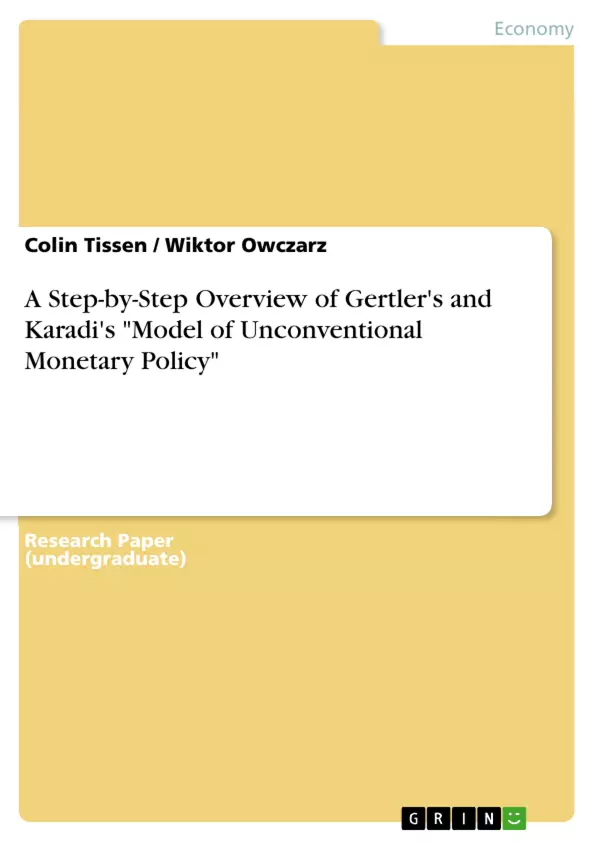Our goal in this paper is to replicate the model of Gertler and Karadi (2011) and to give an elaborate overview of the way in which this model works. Instead of showing the final results, we provide a step-by-step overview of all the necessary calculations and derivations that lead to the ultimate model. Our last objective is to explain the relevance and the impact that the paper of Gertler and Karadi had. First, we describe the model with separate sections for the different agents that play a role in the model: households, financial intermediaries, intermediate goods firms, capital producing firms, retail firms, and the government (including the central bank). Secondly, we perform a Taylor approximation and import out model into Matlab. Thirdly, the model is analysed and the results are given. Fourthly, the impact of the Gertler and Karadi paper is discussed.
Inhaltsverzeichnis (Table of Contents)
- Introduction
- Model Description
- Households
- Financial Intermediaries
- Credit Policy
- Intermediate goods firms.
- Capital Producing firms
- Retail Firms
- Resource constraint and government policy
- Log-linearization and the steady state relations
- Equilibrium equations
- The Equilibrium
- Approximation
- Model Analysis
- The parameters
- Model analysis
- Discussion
- Impact of the Gertler and Karadi (2011) paper
- Criticism
- Conclusion
- Appendix: Taylor Approximations
- Euler optimal savings consumption
- Stochastic Discount Rate
- Arbitrage
- Labour supply
- Optimal leverage ratio
- Growth rate of bank's net wealth
- Optimal utilization rate
- Production Function
- Net capital
- Capital Accumulation
- Fisher Relation
- Effective Capital
- Wages
Zielsetzung und Themenschwerpunkte (Objectives and Key Themes)
This paper aims to replicate the model of Gertler and Karadi (2011) which investigates unconventional monetary policy in a context of financial crises. The objective is to provide a detailed overview of the model's functioning, including all necessary calculations and derivations.
- Unconventional monetary policy in the context of financial crises.
- Modeling financial intermediaries and their role in the economy.
- Impact of the Gertler and Karadi (2011) model on the understanding of unconventional monetary policy.
- Analysis of the model's parameters and dynamics.
- Criticism and limitations of the Gertler and Karadi (2011) model.
Zusammenfassung der Kapitel (Chapter Summaries)
The introduction discusses the need for unconventional monetary policy during economic crises, particularly in the context of the 2008 financial crisis. The Federal Reserve's response through credit injections and asset purchases is highlighted, and the role of the Gertler and Karadi (2011) model in understanding these interventions is established.
The model description chapter outlines the various agents within the model: households, financial intermediaries, intermediate goods firms, capital producing firms, retail firms, and the government. The chapter details the behavior and constraints of each agent, setting the foundation for the model's analysis.
The chapter on log-linearization and steady-state relations explains the process of approximating the model's equations and deriving the equilibrium conditions. The steady-state relations provide a baseline for analyzing the model's dynamics.
The model analysis chapter explores the model's parameters and their impact on the overall dynamics. It examines the transmission mechanisms of unconventional monetary policy and its effects on key macroeconomic variables.
The discussion chapter analyzes the impact and relevance of the Gertler and Karadi (2011) model, exploring its contributions to the understanding of unconventional monetary policy. The chapter also addresses criticisms and limitations of the model.
Schlüsselwörter (Keywords)
Unconventional monetary policy, financial crises, financial intermediaries, agency problem, credit constraints, leverage ratios, Gertler and Karadi (2011) model, model replication, log-linearization, steady-state analysis, macroeconomic dynamics.
- Citar trabajo
- Colin Tissen (Autor), Wiktor Owczarz (Autor), 2017, A Step-by-Step Overview of Gertler's and Karadi's "Model of Unconventional Monetary Policy", Múnich, GRIN Verlag, https://www.grin.com/document/376747



